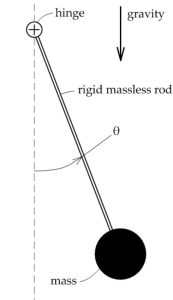16 APPLICATIONS
16.1 State-space models of linear dynamical systems.
Definition
Many discrete-time dynamical systems can be modeled via linear state-space equations, of the form
![]()
where ![]() is the state, which encapsulates the state of the system at time
is the state, which encapsulates the state of the system at time ![]() contains control variables,
contains control variables, ![]() contains specific outputs of interest. The matrices
contains specific outputs of interest. The matrices
![]()
are of appropriate dimensions to ensure compatibility of matrix multiplications.
In effect, a linear dynamical model postulates that the state at the next instant is a linear function of the state at past instants, and possibly other ‘‘exogenous’’ inputs; and that the output is a linear function of the state and input vectors.
A continuous-time model would take the form of a differential equation
![]()
Finally, the so-called time-varying models involve time-varying matrices ![]() (see an example below).
(see an example below).
Motivation
The main motivation for state-space models is to be able to model high-order derivatives in dynamical equations, using only first-order derivatives, but involving vectors instead of scalar quantities.
 |
Consider, for instance, the second-order differential equation: |
|
|
|
| which captures the dynamics of a damped mass-spring system. In this equation: | |
The above involves second-order derivatives of a scalar function ![]() . We can express it in an equivalent form involving only first-order derivatives, by defining the state vector to be
. We can express it in an equivalent form involving only first-order derivatives, by defining the state vector to be
![]()
The price we pay is that now we deal with a vector equation instead of a scalar equation:
![Rendered by QuickLaTeX.com \[\dot{x}(t) = \begin{pmatrix} \dot{y}(t) \\ \ddot{y}(t) \end{pmatrix} = \begin{pmatrix} 0 & 1 \\ -\dfrac{k}{m} & -\dfrac{c}{m} \end{pmatrix}x(t) + \begin{pmatrix} 0 \\[0.5ex] \dfrac{1}{m} \end{pmatrix}u(t).\]](https://pressbooks.pub/app/uploads/quicklatex/quicklatex.com-01f8229bf8c36db933bf81761ca136a9_l3.png)
The position ![]() is a linear function of the state by the relation
is a linear function of the state by the relation ![]() where
where
![]()
A nonlinear system
In the case of non-linear systems, we can also use state-space representations. In the case of autonomous systems (no external input) for example, these come in the form
![]()
where ![]() is now a non-linear map. Now assume we want to model the behavior of the system near an equilibrium point
is now a non-linear map. Now assume we want to model the behavior of the system near an equilibrium point ![]() (such that
(such that ![]() ). Let us assume for simplicity that
). Let us assume for simplicity that ![]() .
.
Using the first-order approximation of the map ![]() , we can write a linear approximation to the above model:
, we can write a linear approximation to the above model:
![]()
where
![]()

